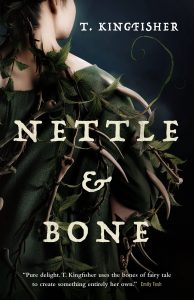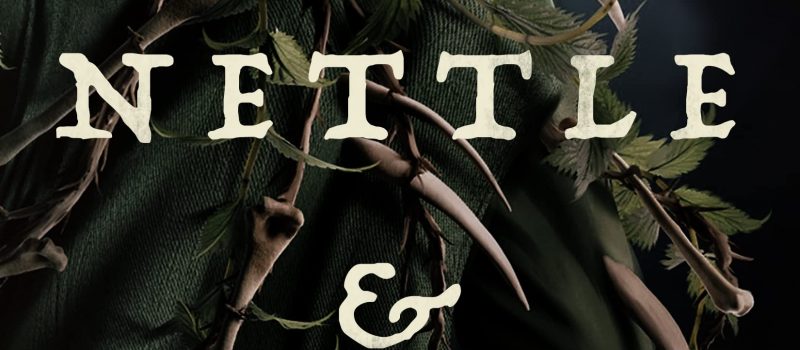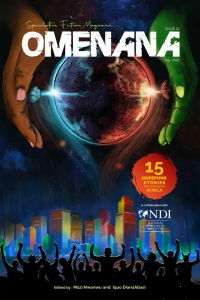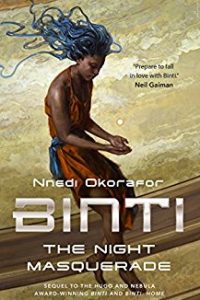Liz Bourke Reviews Nettle & Bone by T. Kingfisher
 Nettle & Bone, T. Kingfisher (Tor 978-1-25024-404-8, $25.99, 256pp, hc) April 2022.
Nettle & Bone, T. Kingfisher (Tor 978-1-25024-404-8, $25.99, 256pp, hc) April 2022.
Kingfisher, as many of us know, is the open pen name of Ursula Vernon. Vernon is an award-winning author under both names, and her novels and stories as Kingfisher are united by their combination of pragmatism among characters and peculiarity in worldbuilding, with a strong sense of humour and a definite impression that, given a choice between several options, Kingfisher will choose the one most likely to turn out weird. (I haven’t read her two horror novels. I imagine they share many of the same characteristics.)
Nettle & Bone shares this combination of the peculiar and the pragmatic. Like many of Kingfisher’s novels, it draws on fairytale elements in its worldbuilding; like most of them, it’s strongly concerned, in its own way, with ethics, with power, and with what you do in response to cruelty.
This has a dog made of bones, a dust-wife, a demon chicken, a man rescued from a goblin market, a magical godmother better at curses than blessings but determined not to do harm – and Marra, so determined that even impossible tasks won’t put her off.
Marra is the third daughter of the ruling family of a very small and not very powerful kingdom. Her eldest sister – Damia, beautiful, beloved – is married off to the prince of a neighbouring, much more powerful kingdom. Shortly thereafter, she comes home in a coffin, and Marra’s middle sister – Kania, who Marra knows hates her – is sent to take her place. Marra is sent to a convent, to Our Lady of the Grackles, until Kania produces the desired male heir, held in reserve, although she doesn’t realise it until much later.
Marra likes the convent much more than she liked palace life. She can learn things, and be useful, and not have to guard her words. But she gradually comes to realise that Prince Vorling is an extremely cruel man who killed her eldest sister and is beating her middle sister, and is essentially killing her by keeping her pregnant with children that she constantly miscarries. He will kill her, once she provides a son. And Marra… well, Marra decides that she’d better kill him first. There’s only one problem: Vorling, like all his ancestors and descendants, is protected by the actions of a powerful magical godmother. To have any hope of success, Marra needs magical help. She needs a powerful dust-wife, essentially a witch of the graveyard, who can command the dead, so she sets out from the convent on a quest that will end up seriously testing her capabilities and her will.
She finds her dust-wife, in the end. She also builds herself a dog made of bones, and rescues a handsome and competent man from a fairy market. His name is Fenris. The inevitable romantic arc develops naturally, believably, with Kingfisher’s usual sense of humour and attention to the absurd. (Part of me wants to believe that naming him Fenris is supposed to evoke Dragon Age II, rather than the wolf of Ragnarok. But what’s in a name, after all?)
Humour is, I think, the most difficult of all the arts, particularly when you’re balancing the humorous with the truly serious. With its subject matter and themes, Nettle & Bone would be a grim novel without Kingfisher’s light touch. Take Marra’s own magical godmother, Agnes. She’d be great at cursing and dark magic. Instead she names her chickens, feels bad about hurting mice, and wishes health on all the children brought to her for blessing. As it is, some sections, such as Marra’s time among the bones, or her and her companions’ search through the catacombs, are dark enough to unnerve. Kingfisher’s humour gentles the harder edges, and Marra’s pragmatism and unassailable – if not unflinching – determination damn well earns a happy ending.
Nettle & Bone has excellently bizarre worldbuilding. My favourite element is the dust-wives, and the dust-wife who joins Marra in her quest is a fascinating character, though I confess I find all of the characters compelling, Marra most of all.
Kingfisher’s work, with its striking voice, humanity, and gift for the relatable weird, never fails to remind me of Terry Pratchett at his best, and Nettle & Bone at times reminds me strongly of some of Pratchett’s witches – albeit updated in line with the developing sensibilities of the last half-decade. And, as with so much else of Kingfisher’s work, the more I read of Nettle & Bone, the more I loved it. I recommend it highly.
Liz Bourke is a cranky queer person who reads books. She holds a Ph.D in Classics from Trinity College, Dublin. Her first book, Sleeping With Monsters, a collection of reviews and criticism, is out now from Aqueduct Press. Find her at her blog, her Patreon, or Twitter. She supports the work of the Irish Refugee Council and the Abortion Rights Campaign.
This review and more like it in the February 2022 issue of Locus.
 While you are here, please take a moment to support Locus with a one-time or recurring donation. We rely on reader donations to keep the magazine and site going, and would like to keep the site paywall free, but WE NEED YOUR FINANCIAL SUPPORT to continue quality coverage of the science fiction and fantasy field.
While you are here, please take a moment to support Locus with a one-time or recurring donation. We rely on reader donations to keep the magazine and site going, and would like to keep the site paywall free, but WE NEED YOUR FINANCIAL SUPPORT to continue quality coverage of the science fiction and fantasy field.
©Locus Magazine. Copyrighted material may not be republished without permission of LSFF.








